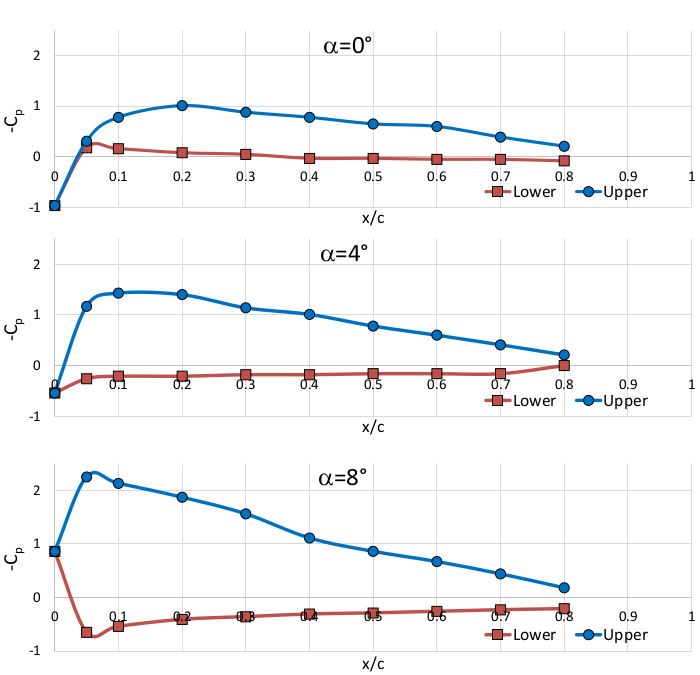机翼行为:克拉克Y-14翼上的压力分布
Overview
资料来源:郭大卫,工程、技术和航空学院(CETA),南新罕布什尔大学(SNHU),曼彻斯特,新罕布什尔州
翼翼是代表关键机翼性能特性的二维机翼部分。压力分布和提升系数是气翼性能的重要参数。压力分布与翼子板产生的升力直接相关。Clark Y-14 翼翼,用于此演示,厚度为 14%,在较低的表面平坦,从弦长的 30% 到背面。
在这里,我们将演示如何使用风洞测量翼翼周围的压力分布。具有 19 个压力端口的 Clark Y-14 翼翼模型用于收集压力数据,用于估计提升系数。
Principles
翼翼通过上表面的较低量量压力和下表面相对于接近空气(自由流压力)的压力施加更高的量力压力,以不同角度进行提升。如果忽略与翼表面平行的剪切力(通常它们对提升的贡献很小),则总压力力是翼翼产生提升的原因。图 1 显示了机翼上压力分布的示意图。

图 1.在翼上的压力分布。
翼上的任意点的非维压力系数 Cp定义为:
 (1)
(1)
其中P是绝对压力,P =是不受干扰的自由流压力,P计 = P = P= P =是计压力,是 动态压力,这是基于自由流密度的, =[ ]和空速,V=。
动态压力,这是基于自由流密度的, =[ ]和空速,V=。
非维提升系数Cl的定义类似:
 (2)
(2)
其中L'是每单位跨度的提升,c是翼的弦长度。
除沿前沿点的点外,压力力均匀地向上指向,方向与提升大致相同。因此,在小攻击角度下,提升系数可通过以下角度进行估计:
 (3)
(3)
其中 x 是从前缘开始的原点水平坐标位置。
翼翼性能考虑雷诺编号 Re,其定义为:
 (4)
(4)
其中新参数=是流体的动态粘度。
在这里,沿机翼的整体压力分布通过嵌入机翼并连接到压力传感器的 19 个小管进行测量。Clark Y-14 翼翼如图 2 所示。它的厚度为14%,在较低的表面上是平坦的,从弦长度的30%到背面。

图 2.Clark Y-14 机翼的翼材,具有量高量压力端口的位置。
测量量表压力使用压力计面板,该面板上装有 24 列,上面装满了标有水英寸刻度的液体油。使用以下公式确定水盖压力读数:
 (5)
(5)
其中 μh是压力计与自由流压力的身高差,μ L是压力计中液体的密度,g是重力引起的加速度。
一旦获得压力分布,就可以以数值确定非维提升系数Cl,以计算公式 3:
 (6)
(6)
其中 #xi是两个相邻端口之间的增量。
Procedure
- 拆下测试部分的顶盖以安装 Clark Y-14 型号(弦长度,c = 3.5 in)。测试部分应为 1 英尺 x 1 英尺,风洞应能保持 140 mph 的最大空速。
- 将铝 Clark Y-14 型号安装在测试部分内的转盘上,以便端口#1面向上游。更换顶盖。请注意,模型同时接触风洞测试部分的地板和天花板,因此在翼翼周围没有 3D 流量。
- 分别将标有 1 - 19 的 19 个压力管连接到压力计面板的相应端口。Clark Y-14 型号上的端口位置如下:端口 1: x/c = 0(位于前缘右侧)、端口 2 和 11:x/c = 5%,端口 3 和 12:x/c = 10%,端口 4 和 13:x/c = 20%,端口 5 和 14:x/c = 30% 端口 6 和 15: x/c = 40%,端口 7 和 16:x/c = 50%,端口 8 和 17:x/c = 60%,端口 9 和 18:x/c = 70%,端口 10 和 19:x/c = 80%(图 2)。压力计面板应有 24 根柱,内注有彩色油,并标有水寸刻度。
- 旋转转盘,使攻击角度为 0°。
- 以 90 mph 的速度运行风洞,并通过读取压力计记录所有 19 个压力测量值。
- 对 4 和 8° 的攻击角度重复步骤 4 和 5。
Results
实验结果如表1及表2所示。数据图3显示了压力系数 C p与压力端口坐标 x/c,用于 0、4 和 8° 的攻击角度。为了更加直观,负 Cp值绘制在水平轴上方。这表明上表面(图表的上线)大部分是负压,下表面(图表的底线)主要是正压。
从图 3 开始,压力在领先边缘后立即显著变化:压力达到其最小值(或最大绝对值),约为 5% - 15% 和弦长度。因此,一半的提升是在翼子琴长度的第一季度产生的。此外,上表面比下表面的提升力更大:在所有 3 种情况下,上表面的贡献率约为总提升的 70 - 80%。因此,在机翼顶部保持清洁和坚硬的表面至关重要。
| 压力端口# | 端口坐标 x/c | 从压力计(在水中)的P 量计 | 计算压力系数Cp |
| 1 | 0.0 | 3.7 | 1.00 |
| 2 | 0.05 | -1.2 | -0.67 |
| 3 | 0.10 | -3.0 | -1.00 |
| 4 | 0.2 | -3.9 | -0.79 |
| 5 | 0.3 | -3.4 | -0.57 |
| 6 | 0.4 | -3.0 | -0.55 |
| 7 | 0.5 | -2.5 | -0.53 |
| 8 | 0.6 | -2.3 | -0.33 |
| 9 | 0.7 | -1.5 | -0.31 |
| 10 | 0.8 | -0.8 | -0.20 |
| 11 | 0.05 | -0.7 | 1.00 |
| 12 | 0.10 | -0.6 | 0.29 |
| 13 | 0.2 | -0.3 | 0.28 |
| 14 | 0.3 | -0.2 | 0.24 |
| 15 | 0.4 | 0.1 | 0.22 |
| 16 | 0.5 | 0.1 | 0.21 |
| 17 | 0.6 | 0.2 | 0.21 |
| 18 | 0.7 | 0.2 | 0.21 |
| 19 | 0.8 | 0.3 | 0.21 |
表 1.零攻击角的实验结果。

图3.压力系数分布,Cp, vs 位置坐标, x/c.
| 攻击角度 | 提升系数cl |
| 0° | 0.53 |
| 4° | 0.89 |
| 8° | 1.29 |
表2.提升系数,cl,根据压力分布估计(Re = 2.34 x 105)。
| 参数 | 值 |
| 空气密度= | 0.00230 slug/ft3 |
| 水密度=L | 1.935 slug/ft3 |
| 重力加速度g | 32.17 英尺/s2 |
| 粘度m | 3.79 x 10-7 lbf_s/ft2 |
| 自由流空速V| | 90 英里/小时 |
| 雷诺兹编号Re | 2.34 x 105 |
| 弦长度 c | 3.5 in |
表 3.用于计算的参数。
Application and Summary
机翼上的压力分配与升降器的产生直接相关,也是描述翼子板性能的重要信息。机翼设计师操纵压力分布,以获得所需的翼板特性。因此,压力分布信息是飞机开发过程中空气动力学分析的基础。
在本次实验中,在风洞中研究了Clark Y-14的压力分布,并测量了19个压力端口,以发现机翼上部和下表面的压力分布。提升系数也根据压力分布数据合理计算。
Tags
跳至...
此集合中的视频:

Now Playing
机翼行为:克拉克Y-14翼上的压力分布
Aeronautical Engineering
21.1K Views

模型飞机的空气动力学性能:DC-6B
Aeronautical Engineering
8.3K Views

推进器特性:音高、直径和叶片数在性能上的变化
Aeronautical Engineering
26.4K Views

Clark Y-14 翼性能:高提升设备的部署(片和板条)
Aeronautical Engineering
13.4K Views

湍流球法:评估风洞流量质量
Aeronautical Engineering
8.7K Views

交叉圆柱流:测量压力分布和估计阻力系数
Aeronautical Engineering
16.2K Views

喷嘴分析:沿聚合和融合分流喷嘴的马赫数和压力的变化
Aeronautical Engineering
37.9K Views

施利伦成像:一种可视化超音速流特性的技术
Aeronautical Engineering
11.6K Views

水隧道中的流量可视化:在三角洲翼上观察前沿涡流
Aeronautical Engineering
8.1K Views

表面染料流可视化:观察超音速流中条纹模式的定性方法
Aeronautical Engineering
4.9K Views

皮托静态管:测量气流速度的设备
Aeronautical Engineering
49.0K Views

恒温测量:研究湍流边界层流的工具
Aeronautical Engineering
7.2K Views

压力传感器:使用皮托静态管进行校准
Aeronautical Engineering
8.5K Views

实时飞行控制:嵌入式传感器校准和数据采集
Aeronautical Engineering
10.3K Views

多直升机空气动力学:六轴飞行器上的特征推力
Aeronautical Engineering
9.1K Views
版权所属 © 2025 MyJoVE 公司版权所有,本公司不涉及任何医疗业务和医疗服务。